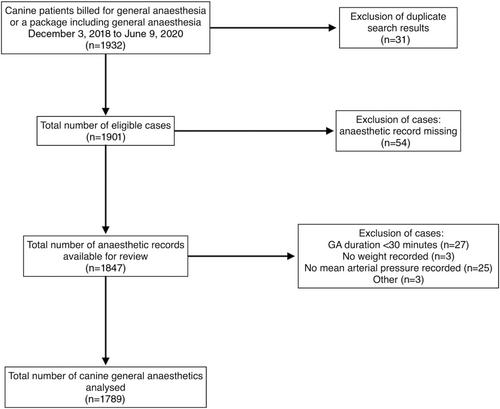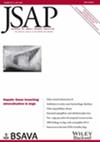Association between body mass and hypotension in dogs under general anaesthesia
Abstract
Objectives
To investigate the association between body mass and hypotension during general anaesthesia in dogs undergoing surgical and diagnostic procedures within a referral hospital.
Materials and Methods
Retrospective evaluation of the anaesthetic records of 1789 dogs was performed. Data on signalment, anaesthetic protocol and physiological variables, including mean arterial pressure, were collected. A multivariable generalised linear model was used to identify associations between explanatory variables, including body mass, and hypotension.
Results
In the population studied, increasing body mass (per 10 kg) was significantly associated with decreasing odds of hypotension (odds ratio 0.68; 95% confidence interval: 0.60 to 0.77). Additional variables associated with a decreased odds of hypotension were pre-anaesthetic medication with alpha-2 agonists (odds ratio 0.63; 95% confidence interval 0.48 to 0.82) and increased body temperature (per 1°C) during general anaesthesia (odds ratio 0.77; 95% confidence interval 0.67 to 0.88). Brachycephaly (odds ratio 1.72; 95% confidence interval 1.25 to 2.38), ASA physical status classification >3 (odds ratio 2.03; 95% confidence interval 1.16 to 3.56), undergoing a surgical procedure (versus diagnostic) (odds ratio 1.57; 95% confidence interval 1.10 to 2.23) and bradycardia (odds ratio 1.37; 95% confidence interval 1.05 to 1.80) were independently associated with increased odds of hypotension.
Clinical significance
Dogs of lower body mass and brachycephalic breeds may be at higher risk of hypotension during general anaesthesia or alternatively represent subpopulations in which accurate blood pressure measurement presents a greater challenge. Monitoring blood pressure accurately in these groups requires particular attention and provisions for treating hypotension should be readily accessible.


 求助内容:
求助内容: 应助结果提醒方式:
应助结果提醒方式:


